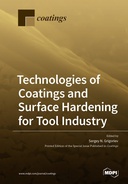Explore

Technologies of Coatings and Surface Hardening for Tool Industry
0 Ungluers have
Faved this Work
Login to Fave
The innovative coating and surface hardening technologies developed in recent years allow us to obtain practically any physical–mechanical or crystal–chemical complex properties of the metalworking tool surface layer. Today, the scientific approach to improving the operational characteristics of the tool surface layers produced from traditional tools industrial materials is a highly costly and long-lasting process. Different technological techniques, such as coatings (physical and chemical methods), surface hardening and alloying (chemical-thermal treatment, implantation), a combination of the listed methods, and other solutions are used for this. This edition aims to provide a review of the current state of the research and developments in the field of coatings and surface hardening technologies for cutting and die tools that can ensure a substantial increase of the work resource and reliability of the tool, an increase in productivity of machining, accuracy, and quality of the machined products, reduction in the material capacity of the production, and other important manufacturing factors. In doing so, the main emphasis should be on the results of the engineering works that have had a prosperous approbation in a laboratory or real manufacturing conditions.
This book is included in DOAB.
Why read this book? Have your say.
You must be logged in to comment.
Rights Information
Are you the author or publisher of this work? If so, you can claim it as yours by registering as an Unglue.it rights holder.Downloads
This work has been downloaded 85 times via unglue.it ebook links.
- 85 - pdf (CC BY) at Unglue.it.
Keywords
- (Al1−xCrx)2O3
- (AlCrX)N
- adaptive coating
- adaptive material
- Adhesion
- adhesive bond strength
- AFM
- AlCr-based
- Ar+
- arc
- Argon
- C+
- carbon flux
- charge exchange collisions
- chemical vapor deposition (CVD) diamond
- coating deposition
- Coatings
- composite powder HSS
- composition and structure
- convection and diffusion
- crack formation
- CrAl-based
- cutting edges
- cutting tool
- diamond-like carbon coating
- diamond-like coatings
- electrical conductivity
- end mills
- Etching
- fast gas atoms
- finish turning
- friction coefficient and wear resistance
- hard alloy
- hardness and elastic modulus
- hierarchical structure
- high-fluence ion irradiation
- high-pressure, high-temperature (HPHT) diamond
- high-speed milling
- HiPIMS
- index of plasticity
- ions
- low-pressure vacuum carburizing
- medium-high alloy steel
- micro cutters
- microdroplets
- microparticles
- milling of aluminum alloys
- milling of structural steels
- modeling
- monocrystalline
- multilayer PVD coating
- nanocomposite
- nanolayered coating
- nanolayered PVD coating
- nanolayers
- nickel alloy
- nitride sublayer
- nitrogen and ethylene
- oxidation resistance
- PCBN
- Plasma
- Properties
- Raman spectra
- reactive magnetron sputtering
- roughness
- secondary structures
- SEM
- sharpening
- SHS and hot pressing
- SiAlON
- spark plasma sintering
- stochastic process
- Structure
- surface layer
- surface quality
- Ta3B4 and ZrB2
- TaSi2
- Technology, engineering, agriculture
- Technology: general issues
- tempered steel
- thermal-force loads
- tool wear
- wear resistance
- wear-resistance
Links
DOI: 10.3390/books978-3-0365-2453-5Editions

